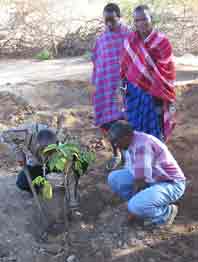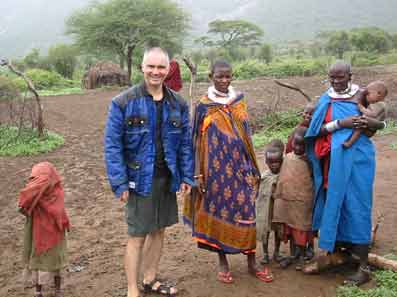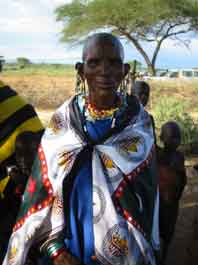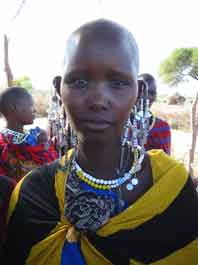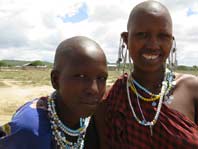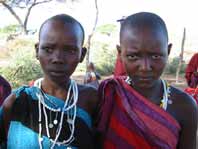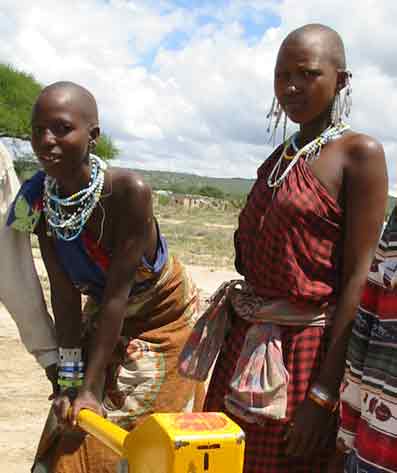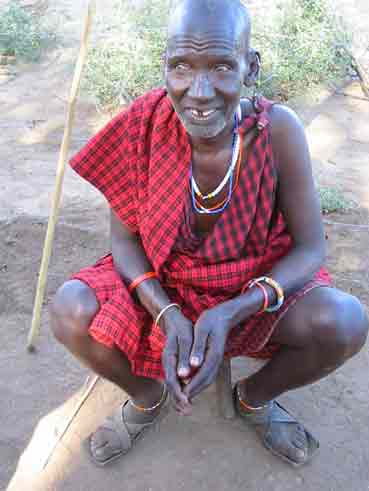Tuesday
3rd Dec.
While visiting the national World Vision office I was told that there were an
annual project coordination committee meeting to be held at Shambarai. This
project is supported not only by World Vision Australia but also by AUSAID and
the Tanzanian Government. They told me that it would be a good idea if I went
along.
Chawewe Immanuel picked me up from the camp at 7am and we drove for one and
half hour to Shambarai. Shambaray is a small town full of young people who are
here to try their luck at the mines of Tanzanite, a precious stone only found
in Tanzania. It is also a region were Maasai people lives.
We meet the district commissioner, a member of the Tanzanian parliament and
some various delegates for a very copious breakfast. Then, they had a very formal
meeting, I was the special guest from Australia, feeling a little intimidated
among all those important people but, as I found out later on, I become the
most important person of the day.
The meeting was over two days, the first one was spent at visiting different
programmes and the second at reporting of their progress and what can be down
to improve them.
The Shambaray region has a very high number of HIV/AIDS sufferers due to the
high level of human interaction of the mobile populations - miners and the Maasai
people.
Already there is a very big problem with HIV/AIDS in Africa, there are 43 million
people over the world suffering from it and in Africa only there are 30 million.
The reason it's so high is because of the slow reaction of the Africans governments
when it first appeared, they were saying to people that it was propaganda from
white people in order to slow down the population gross and people believed
it. That is one reason; the other is because of the isolation of a lot of tribes
or people, making it very hard to educate them.
The miners come from all over the place and great a demand for commercial Sex.
The Maasai also works in the mines and have sex with the prostitutes, then,
when they go home pass it on to their spouses, who pass on to other men in the
village as men of same age group share wives. Moreover there is a traditional
dance, which involves young Maasai men and young Maasai girl; the young girls
are encouraged to have sex with many young men. The Maasai have little or no
understanding of hiv/aids epidemic because of their nomadic lifestyle and detachment
from all other communities.
With such a problem, a project was created in 2000 to educate and counselled
the people. The purpose of it was to reduce transmission of HIV through sustainable
primary health care, social support and behavioural change. Unfortunately this
project is due to stop in September 2003 with lack of funds.
Our first stop was at the counselling office. They have a programme on a television
which educate the locals on HIV, people can then volunteer to have a test, if
found positive they will go through counselling to help them cope. Since last
June, 1800 tests were conducted and 800 were found positive. As those numbers
show, aids is out of control in this region.
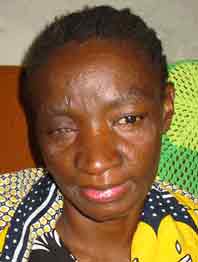
Then
we went to visit some aids sufferers in their home. One lady (pictured) had
lost her husband from the disease and was very sick herself but she was very
happy to see us paying her a visit in her very humble home.
We also visited a school for orphans and a primary school; at both places we
were welcome with songs and dances by the children. To finish the day, we went
to a water hole, once again we were welcome with singing and dancing but this
time it was by Maasai people, we were also given a handmade necklace each.
We
also planted some trees (picture).
It is very good to see how and where the money is spent but every time, I am
left with the feeling that there could be so much more that could be done to
help the children.
I had a great day, tough at times but rewarding at others.
Thank you to all the people that translated everything for me and took the time
to explain things to me.
Friday
6 Dec.
Today is the end of the Ramadan, so it's public holiday all over the place and
time for me to keep going. The rain woke me up and there was water in the tent
as well, not a good start for the day but, after folding the tent and packing
everything, I left the camp in the direction of Kenya, 100km away.
I stopped in Longido, a small village of mainly Massai people 80km from Arusha.
They have a cultural programme were you can give a donation to the community
and in exchange you gain an insight into the culture and daily life of the Maasai.
The Massai are a nomadic tribe but due to land-use conflicts and other restrictions,
they are now forced to stay in one place. They are herders of cattle, sheep
and goats. They eat mainly meat, blood and milk; occasionally they will eat
corn when milk runs out. The boys get circumcise at sixteen and this is the
most important time of their life because then they become men, from the age
of eighteen to thirty nine they are warriors and their job is to protect their
families, their herds and the whole village.
The girls get circumcise at thirteen, then they get married. It's the parents
of the boy that choose the wife and they have to pay by giving seven cattle
to the parents of the girl. The more cattle you have the more wives you can
buy. As I have mention it before, when a man invites his friend to his house,
his friend is welcome to use the house and the wife, the husband just goes away
for awhile (in those condition I would definitely stay single).
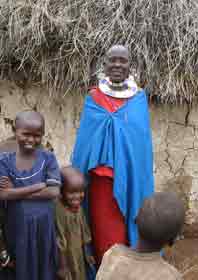
I
was welcome by a Maasai lady and together we walked, in the rain, for an hour
to her boma (a small group of huts for the whole family). The huts are built
in a circle, roughly fifty feet apart and are enclosed within a large protective
perimeter of impenetrable thorn bush, which is also the corral in which the
cattle are kept at night, usually leaving three or four gates, also of thorn
bush. These are opened in the morning to allow the cattle out and closed again
in the evening once the cattle are back inside, to protect them from lions or
similar animals.
The huts are constructed and owned by the women. They are made of fine twigs,
either Leleshwa, sage or similar which are shaped into a low dome-like structure
about five to six-feet high, and covered with a light layer
of
grass if it is available, or branches with leaves. The huts are then plastered
with a one-inch layer of fresh cow dung, which is collected each morning, the
plastering continuing until the hut is considered complete. They last up to
seven year.
I was invited in one of the hut for a cup of tea. It was very dark inside as
there is only a small hole, about five inches in diameter, to leave the smoke
out from cooking fire and light, no other windows whatsoever. Inside, there
were two beds made of wooden frames, which were covered with hides. One bed
was completely inclosed in a small chamber with cow dung walls, leaving a little
entrance for the occupant. This bed belonged to the woman of the house. Opposite
and about five feet away was a larger bed, up to ten feet wide, but only partly
enclosed. Visitors- other than the favoured guest, who will share the bed of
the woman of the house, if she so chooses, use this bedchamber. One woman was
brushing her teeth with a piece of wood and spat on the floor every now and
then, another one was in one of the bed with a two weeks old baby, a woman,
with a new born baby, has to stay at least five weeks inside the hut before
being allowed out.
All in all it was a very interesting experience for me. I spent the night in
the village and left early the next morning.
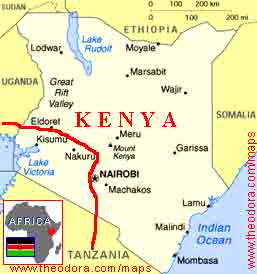
The
Kenyan border was only 25km away; the rain had stopped which pleased me.
Even though the border crossing went without any hassles I was pissed off to
have to pay US$50 for the visa, US$40 for the insurance and US$25 for road permits
which I knew nothing about.
I went through Nairobi (Nairobbery as people like to call it) without any problem,
even managed to change some money, kept going and passed the Equator in the
afternoon (did not feel a thing) and stopped at Eldoret for the night just 200km
from the Uganda border.
The hotel was revolting and noisy but there were nothing else around.
Next
morning I was on the road early, clad to be out of the crappy hotel and being
a Sunday there was not much traffic on the road. By 9am I was at the Uganda
border, I knew that I needed a visa but did not have one. Will they let me in
or will I have to ride all the way back to Nairobi to get one?
Do not miss the next update as everything will be revelled.
Just click here to view more photos.
Le
problème du sida en Afrique.
Mardi
3 Dec.
Il y a 43 millions de gens qui souffrent du sida dans le monde entier, en Afrique
seulement il y en a déja 30 millions, plus des deux tiers. La raison
principale de ce haut niveau est due principalement à la réaction
trés lente des gouvernements Africains quand la maladie a fait son apparition
il y a vingt ans. Certains gouvernements allaient jusqu'à dire que c'était
de la propagande venant des pays de l'Ouest pour ralentir l'augmentation de
la population en Afrique. Une autre raison pour ce haut niveau c'est qu'il y
a beaucoup de tribues isolées, sans contact avec le reste du monde, il
y a encore beaucoup de gens en Afrique qui n'ont jamais entendu parler du sida.
World Vision participe trés activement à l'éducation des
enfants et de la population en général de cette épidémie
dans les régions les plus isolées.
Quand il m'ont invités à visiter un des projets ou l'éducation
du sida est trés importante, je n'ai pas hésité.
Chawewe Immanuel, responsable du project de Shambarai, est venu me chercher
a sept du matin, une heure et demie plus tard nous arrivions à Shambarai.
Nous étions accueillis par le préfet et aussi par un des membres
du parlement du gouvernement de Tanzanie.
Shambarai est une région minière de Tanzanite, pierre trés
précieuse trouvée seulement en Tanzanie. Des gens de tout le pays
y viennent pour y trouver fortune. Ce qui veut dire que dans le village, la
prostitution est trés élevée, les femmes essayent de gagner
de l'argent comme elles peuvent, juste pour nourrir leurs familles. Il y a aussi
beaucoup de Maasai dans la région, ces gens là ont une grande
libertée sexuelle, les hommes ont plusieurs femmes et ils offrent leurs
femmes à leurs amis. Donc le sida bat son plein dans cette région,
la mission de World Vision et du gouvernement de Tanzanie est de controler,
informer et protéger la population contre ce fléau.
Nous avons passés la journée à parler aux gens atteint
du sida, à voir ce qui est fait pour eux, comment ils sont soignés.
Nous avons aussi visités des écoles, parlés aux enfants
pour connaitre leurs éducations sur cette maladie.
World Vision a crée des cliniques ou les gens viennent regardés
à la télévision des programmes pour les informés
sur le sida. Ils peuvent aussi avoir un prélévement de sang pour
voir s'ils sont positif. Ils ont éxaminés 1800 personnes dernièrement,
800 étaient positif.
Merci à tout les gens qui ont pris le temps de tout m'expliquer et de
tout me traduire, c'était une journée dure moralement mais trés
éducative sur un autre plan.
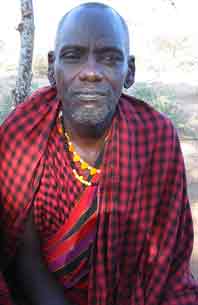
Vendredi 6 Dec.
J'étais révéillé assez tôt par la pluie, il
y avait même de l'eau dans la tente, j'ai pris la route en direction du
Kenya, 100km plus au nord. A 20km de la frontière je me suis arrêté
à Longido, petit village de Maasai, pour une visite culturelle et aussi
pour en savoir plus sur leurs traditions, leurs habitudes et leurs coutumes.
J'ai été accueilli par une femme Maasai et ensemble nous avons
marchés sous la pluie pendant une heure jusqu'à son Boma (plusieurs
huttes pour toute la famille).
Les Maasai étaient des nomades mais maintenant, à cause de la
vente de beaucoup de terrain, ils ne se déplacent plus beaucoup car il
ne reste presque plus de terrain de libre. Ils vivent de leurs troupeaux de
vaches, chèvres et moutons, ils se nourrissent principalement de viande,
de
sang
et de lait, quand il n'y a pas beaucoup de lait ils mangent un peu de maïs.
Ils vivent dans des huttes faites en terre et bouse de vaches, ces huttes sont
construites et appartiennent aux femmes seulement. Les huttes sont entourées
de clotures faites de ronces, le soir ils rentrent les animaux dans l'enceinte
pour les protéger des animaux sauvages (lions, hyène, etc..) .
Les garçons sont circonsicés à 16 ans, une cérémonie
trés importante dans la vie d'un Maasai, les filles sont mutilées
vaginalement à 13 ans ensuite elles sont mariées. Ceux sont les
parents du garçon qui choisissent sa femme, ils doivent la payée
avec 7 vaches, si le garçon devient riche, c'est à dire qu'il
a beaucoup de vaches, il va s'acheter d'autres femmes.
Comme je l'ai dis auparavant, le mari peut inviter un ami chez lui et l'ami
peut coucher avec sa femme pendant que lui va chez une autre de ces femmes.
Ce qui veut dire que le mari ne sait pas souvent qui est le pére de ces
enfants, mais cela n'a pas l'air d'être trés important pour eux,
à partir du momnt que l'enfant est née dans sa maison il le considere
son fils. (moi, si j'étais Maasai je resterai célibataire).
J'ai été invité dans une des huttes pour prendre une tasse
de thé. Il faisait trés sombre à l'intérieur car
il n'y a pas de fenêtres, juste un trou d'environ 40cm pour laisser la
fumée s'échapper. Il y avait deux lits,dans la pièce, un
pour la femme et un pour le mari ou l'invité. Une des femmes se néttoyait
les dents avec un morceau de bois et crachait parterre de temps en temps, une
autre était couchée avec son enfant de deux semaines. Quand une
femme accouche elle doit rester au lit pendant 5 semaines avec son enfant sans
sortir dehors. Un feu etait allumée au milieu de la pièce, la
fumée me piquait les yeux .
Tout ça était trés intérréssant pour moi
et j'ai passé une agréable journée parmis eux, j'ai passé
la nuit au village et le lendemain matin je reprenais la route vers le kenya,
la pluie avait cessée et je me sentais bien, malgré la frontière
a proximitée.
J'ai du payé environ 50 EUROS pour le visa, 40 EUROS pour l'assurance
de la moto et 20 EUROS pour une taxe routière, la journée commençait
bien, bonjour les économies, à cette allure là je vais
être fauchée avant d'avoir fini l'Afrique.
Je m'arrêtais juste quelques minutes à Nairobi pour changer de
l'argent, dans l'aprés midi je passais l'équateur (sans le voir)
et je faisais une pause pour la nuit dans une petite ville à 200km de
la frontière d'Uganda. Je passais la nuit dans un petit hotel trés
bruillant et trés sale prés de la station de buses, faute de camping.
Je reprenais la route de première heure, heureux de laisser cet hotel
minable derrière moi. J'arrivais à la frontière Ugandaise
à 9 heures sans visa. Qu'allait il se passer ? allaient-ils me laisser
passer la frontière ou me r'envoyer à Nairobi chercher un visa
?
Vous le serez trés prochainement sur le site Ride4Kids, le seul site
français avec plein de fautes d'hortographes.
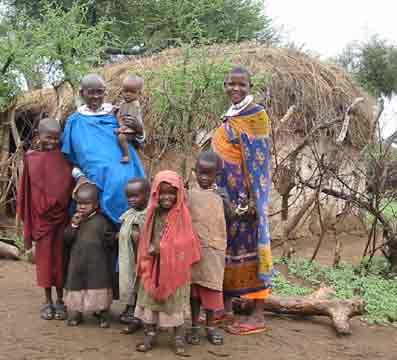
Maasai family at Longido.
Une famille Maasai à Longido.
With my friends at Longido.
Avec mes amis de Longido.
Beautiful Maasai women.
Belles femmes Maasai.
Maasai women fetching water.
Femmes Maasai puissant de l'eau.
A Maasai warrior.
Un homme Maasai.


